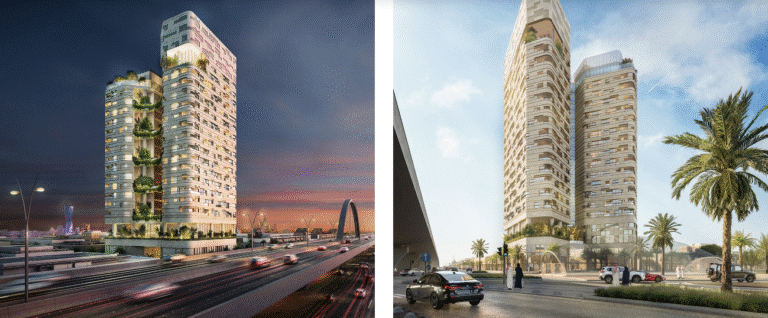When management and the board at 75 Henry Street noticed cracks in some of the balconies of their 33-story co-op building, they decided to act immediately—even though a Facade Inspection Safety Program (FISP) cycle was not yet due. This proactive decision helped prevent potential structural issues from worsening and ensured the safety of residents and pedestrians below. This article explores how the project unfolded, highlighting the importance of preventive maintenance in residential buildings, with a focus on diagnostic steps, timely intervention, and the benefits of acting before mandatory inspection deadlines.

The Discovery: How Did It Start?
In 2018, between FISP inspection cycles, the building’s management and board observed signs of deterioration in several balconies. These balconies were constructed using steel-reinforced concrete in 1968, when the building was originally built. Using binoculars, engineers noted cracks and peeling paint along the corners and edges—areas most vulnerable to weather exposure.
A key design flaw contributing to this issue was the direct penetration of balcony railings through the concrete curbs, especially at corners, which created weak points where cracking commonly occurs over time.
Diagnosis: A Thorough On-Site Evaluation
Following the visual inspection, a hands-on assessment was conducted using a technique called “hammer sounding” along the outer edges of each balcony. The results showed that the steel reinforcement was positioned very close to the surface of the concrete, making the structure more prone to spalling and cracking.
This type of evaluation is crucial for identifying the extent of damage and determining which areas require repair or full replacement.
Repair Plan: Designing and Implementing Solutions
Based on the findings, a comprehensive repair plan was developed, including:
- Removal and replacement of damaged concrete curbs
- Casting new curbs and hammering back or adding steel reinforcement
- Repairing and securing balcony railing posts
- Patching the undersides of damaged balconies
- Applying a weather-resistant protective coating system by BASF to all balcony surfaces
Approximately 85% of the balconies required some level of repair. The project was completed within six months without any major setbacks, demonstrating the effectiveness of accurate diagnosis and well-planned execution.
Why Early Action Matters: Avoiding Future Risks
It’s common for maintenance work to be postponed until mandatory inspections are due. However, delaying repairs can lead to increased damage and higher costs down the line. In the case of 75 Henry Street, acting early offered multiple advantages:
- Ensured public and resident safety: Prevented the risk of falling debris.
- Reduced long-term costs: Addressing problems early avoids larger-scale interventions later.
- Extended building lifespan: Regular maintenance preserves structural integrity and maintains property value.
According to the New York City Department of Buildings, “Preventive maintenance reduces the risk of unexpected failures and helps ensure compliance with local regulations such as FISP.”
Source: NYC Department of Buildings – Facade Inspection Safety Program

ArchUp Insight: Analysis and Opinion
The 75 Henry Street balcony repair project serves as an excellent example of how aging buildings can be effectively maintained through early detection and timely action. The board’s decision to intervene ahead of schedule reflects a high level of professional awareness and responsibility.
However, one area worth reconsidering is the lack of a continuous annual maintenance plan. Relying solely on five-year FISP inspections may not be sufficient. A more proactive, year-round monitoring system could help catch similar issues even earlier.
Additionally, while applying a weather-resistant coating was a smart final step, it functions more as a temporary solution. The core issue lies in the original structural design—especially the placement of reinforcing steel near the surface. Long-term fixes should consider structural adjustments during major renovations.
Summary Table of Key Points
| Element | Details |
|---|---|
| Location | 75 Henry Street, New York City |
| Number of Floors | 33 floors |
| Balcony Type | Steel-reinforced concrete, over 50 years old |
| Identified Issues | Cracks at corners, exposed steel reinforcement |
| Repair Steps Taken | Curb replacement, railing repair, protective coating |
| Project Duration | 6 months |
| Percentage of Balconies Repaired | Approximately 85% |
Frequently Asked Questions About Balcony Maintenance
| Question | Answer |
|---|---|
| Why are balconies considered a weak point in buildings? | They are constantly exposed to weather and require precise structural design to handle loads and vibrations. |
| Should I wait for a FISP inspection before repairing my balcony? | No, it’s better to address visible cracks or damage as soon as possible rather than waiting for scheduled inspections. |
| What is the difference between temporary and permanent balcony repairs? | Temporary fixes address symptoms, while permanent solutions deal with the root structural causes. |
| Can small cracks in a balcony be ignored? | No, small cracks can grow over time and lead to serious structural issues if left unattended. |
| How should I begin inspecting my balcony? | Start with a visual check, then consult a licensed engineer for a thorough assessment. |
Conclusion
The 75 Henry Street balcony repair project offers valuable lessons for building owners and boards. Preventive maintenance is not a luxury—it is a necessity that protects lives and preserves investments. The real challenge moving forward is shifting from reactive to proactive maintenance practices, ensuring that aging buildings remain safe and functional for decades to come.







